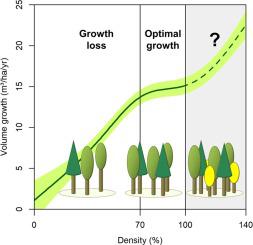Forest Ecology and Management ( IF 3.7 ) Pub Date : 2021-01-18 , DOI: 10.1016/j.foreco.2020.118909 Eric Andreas Thurm , Hans Pretzsch

|
Forest management mainly controls wood growth through the regulation of stand density. Knowledge of the growth–density relationship is based on numerous studies in pure stands. Currently, in times of more climate plasticity and more nature-oriented forests, silviculture with mixed stands is demanded of forest policy. It is well known that the competition mechanisms in mixed stands are different to those of pure stands. Hence, the question arises for forest managers whether the regulation of density must be different, too.
In an attempt to answer this question, we investigated 481 stand surveys from 124 long-term experimental plots of European beech stands, mixed with conifers and also broadleaf trees. With generalized additive models, we estimated the influence of the density on stand volume growth and how it changed with stand development and shade tolerance of the admixed species. The density of the mixed stands was given on a relative scale. 100% density took into account the maximum species-specific density plus a mixed stand specific addition.
We found that mixed stands have a constant growth level in the medium- to high-density phase (70–100%). Although we have tried to take into account the higher density in mixed stands, 10% of the stands outperformed the 100% benchmark and exhibited a growth gain in this over-dense phase (>100%). Finally, the growth-density response resembles a cubic function with a saddle or optimum between medium- to high-density phase and an increase of growth in the low-density and the over-density phase. The inclusion of stand development led to the oblation of the growth–density response in younger ages. The admixture of shade-intolerant species with beech caused a more intensified cubic course of the relationship.
Finally, we could show that a short-term decrease of the density also has an effect on growth. In terms of growth, weak thinnings are better than severe thinnings. Thinnings from above have a significant positive effect on growth, especially for longer observation periods of up to 10 years.
We concluded that mixed stands need an adapted thinning compared to pure stands. Regular, weak thinnings from above with a very high stand density enables maximum volume growth gains in European beech mixed stands. We could show that the growth-density relationship is conceptually different to pure stands, because mixing effect causes density section above 100%. However, the study emphasizes the need for a systematic experimental setup for a better understanding of intraspecific interactions at different densities.
中文翻译:

混交林中的生长密度关系–长期实验图的结果
森林经营主要通过林分密度的调节来控制木材的生长。有关生长密度关系的知识是基于纯林中的大量研究得出的。当前,在气候可塑性更高,森林更趋于自然的时代,森林政策要求混交林木造林。众所周知,混合林的竞争机制不同于纯林的竞争机制。因此,森林经营者提出了一个问题,即密度的调节是否也必须有所不同。
为了回答这个问题,我们从124个长期的欧洲山毛榉林试验地块(与针叶树和阔叶树混合)中调查了481个林分调查。利用广义的加性模型,我们估计了密度对林分体积增长的影响,以及密度如何随林分发育和混合物种的阴影耐受性而变化。混合林的密度按相对比例给出。100%的密度考虑了最大物种比密度加上混合林分比添加。
我们发现,中高密度阶段混合林的生长水平恒定(70-100%)。尽管我们尝试考虑混合林的较高密度,但有10%的林分优于100%的基准,并且在该过密阶段(> 100%)表现出增长。最后,生长密度响应类似于立方函数,在中密度到高密度阶段之间具有鞍形或最佳状态,而在低密度和过密度阶段则增加了增长。林分发育的纳入导致了幼龄期对生长密度反应的抑制。耐荫性物种与山毛榉的混合导致这种关系的立方过程更加强烈。
最后,我们可以证明密度的短期降低也对生长有影响。就增长而言,薄弱的情况要好于严重的情况。上面的细化对生长具有显着的积极影响,特别是对于长达10年的较长观察期。
我们得出的结论是,与纯林相比,混交林需要适应性变薄。从上方定期进行稀疏稀疏,具有很高的林分密度,可以在欧洲山毛榉混合林中获得最大的体积增长。我们可以证明,生长密度关系在概念上不同于纯林分,因为混合效应导致密度断面在100%以上。但是,该研究强调需要系统的实验装置,以便更好地了解不同密度下的种内相互作用。











































 京公网安备 11010802027423号
京公网安备 11010802027423号